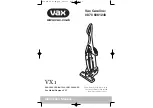
EN
G
LIS
H
EN
G
LIS
H
4 EN
EN 5
• If you intend to use the vacuum cleaner to capture drywalling dust, connect the vacuum cleaner to the
sanding device and ensure that it is equipped with a suitable filter bag.
•
Make sure that no power cables or hoses will get in the way of the vacuum cleaner or the sanding device.
3.2 USE IN DRY CONDITIONS
When vacuuming up dry dust, always install both a filter and a filter bag for drywalling dust!
Once you have taken all necessary safety measures and the vacuum cleaner and the sanding device are
ready for use, switch on the vacuum cleaner first and then the connected tool.
Starting up:
The vacuum cleaner’s motor will not start automatically when you turn on the sanding device connected to
it. To start the industrial vacuum cleaner, first you must connect it to an appropriate power socket and then
flip the switch to the “I” position.
Shutting down:
Flip the power switch to the “O” position to shut off the industrial vacuum cleaner.
Note that the power socket on the vacuum cleaner is not activated or deactivated by the switch next to it –
this switch only turns the vacuum cleaner on and off. The socket will have an electrical current as soon as
the vacuum cleaner is connected to a power source.
The vacuum cleaner’s filter is continually cleaned by a multi-cyclonic system, saving you from constant work
interruptions to clean the filter. However, when you have finished vacuuming dust, you need to remove and
empty out the filter unit. To do this, pull up on the handles on either side of the housing, open the bottom
filter cover, and empty out the dust.
3.3 USE IN WET CONDITIONS
• Never use the vacuum cleaner on flammable, explosive or corrosive liquids! Make certain that the vacuum
cleaner is free of dust before you use it to vacuum liquids. Failure to do this could cause lasting damage
to the vacuum cleaner!
• Before vacuuming liquids, be sure to remove the filter bag.
• Empty out the reservoir once it is one-third full. To do this, remove the reservoir cover and carefully pour
out the liquid.
•
The vacuum cleaner is equipped with a mechanism that will automatically shut off the device once the liq-
uid in the reservoir reaches a certain filling level. However, this feature will not work with non-conductive
liquids, such as certain emulsions, oils and greases. Thus you must check the filling level regularly when
vacuuming up such liquids.
•
Switch off the vacuum cleaner immediately if liquid or foam starts to come out of the housing.
• After using the vacuum cleaner on liquids, always clean the filter, electrodes and reservoir.
2.2 SAFETY IN YOUR WORKING ENVIRONMENT
•
Ensure that your work area is always well-lit so as to prevent accidents.
• Make certain that there are no other people in your working environment (children in particular) who could
distract you while working with the vacuum cleaner.
2.3 OPERATING SAFETY TIPS
• When using the industrial vacuum cleaner to remove dry waste, always attach a dust bag, and use a res
-
pirator mask approved for dust filtering purposes! Also, wear protective clothing, protective glasses and
non-slip work shoes to minimise the risk of injury.
• In order to prevent accidents, before you attach the machine to a power source, ensure that there is no
possibility of the vacuum cleaner being turned on unintentionally. Furthermore, all other tools and operat
-
ing controls should be removed from the working area of the vacuum cleaner.
•
Make certain that any dust suction and capture systems are installed correctly. Also ensure that there
are no faulty switches on the vacuum cleaner, that all moving parts are functioning correctly and that no
parts have broken or fallen off of it.
• Keep your hands, hair, feet and any baggy or loose clothing far away from the machine’s moving parts
and suction nozzles.
•
Use the vacuum cleaner only to vacuum dry dust and non-corrosive liquids.
•
Vacuuming up burning cigarette butts or hot ashes can cause an explosion. Do not let corrosive liquids
get into the vacuum cleaner - they may cause lasting damage to the device. Avoid vacuuming up undi-
luted acids or bases, metallic dust particles (such as aluminium, zinc or magnesium) together with acidic
or basic cleaning solutions, and organic solvents such as petrol.
• When taking breaks or making repairs to the vacuum cleaner, always switch it off and disconnect it from
power first.
• Before vacuuming up liquids, clean the device thoroughly, making sure to remove any dust.
• Only have repairs carried out by qualified professionals.
3. OPERATING THE MACHINE
3.1 STARTING OFF
You must take the following measures before operating the machine for the first time or after the machine
has been transported:
•
Remove all the individual parts from the housing of the industrial vacuum cleaner.
• Make certain the vacuum cleaner is switched off. Check that the power cable of the vacuum cleaner, as
well as those of any devices connected to it (e.g. long-neck sanders) is intact and undamaged (max power
connection of the appliance socket: see “Technical Specifications”).
4 EN
EN 5
ENGLISH
ENGLISH
Содержание VC760
Страница 65: ......















































